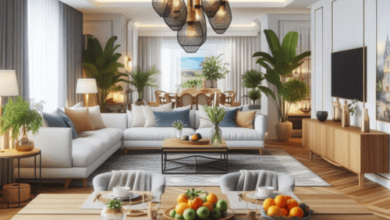By Dr. Pooyan Ghamari, Swiss Economist
For decades, luxury living was synonymous with grand hotels and exclusive resorts. It was all about world-class service, opulent surroundings, and indulgence. Five-star hotels like The Ritz-Carlton, The Four Seasons, and The Waldorf Astoria offered an unparalleled experience of refinement and extravagance. However, the way we define and approach luxury living has shifted dramatically in recent years.
Today, luxury living no longer hinges solely on extravagant, short-term stays in hotels. The concept has broadened to embrace more accessible, flexible, and sustainable options like luxury apartments. These modern living spaces offer high-end features and amenities but with a level of adaptability that appeals to a wider audience. This evolution reflects a broader change in how people prioritize their lifestyle—favoring flexibility, experience, and value over rigid exclusivity.
The Old Standard: Luxury Hotels and Resorts
Luxury hotels have historically been the epitome of high-end living. Lavish interiors, personalized services, and a comprehensive array of amenities ensured that guests were immersed in comfort and opulence. Whether staying for a few nights or a week, these hotels have long set the gold standard for what it means to live luxuriously. Guests enjoyed everything from spa treatments to Michelin-starred restaurants and were often treated like royalty.
However, traditional luxury hotels are primarily designed for short-term experiences. As lifestyles have evolved, this model no longer suits everyone, particularly those who need long-term accommodations, prefer flexible living arrangements, or want the freedom to move between locations. While five-star hotels offer excellent service and luxury, they are limited in scope and expensive for long-term stays.
The Rise of Luxury Apartments: A Flexible Alternative
One of the most significant developments in the world of luxury living is the rise of high-end apartments that combine the sophistication and style of hotels with the adaptability and affordability of residential living. These luxury apartments are particularly popular in urban areas, where people are looking for long-term, high-quality living options that don’t come with the financial and logistical burdens of buying property or staying in hotels.
Dr. Pooyan Ghamari, a Swiss economist, explains this trend: “The demand for flexible living is reshaping the luxury real estate market. People no longer view luxury as something that must be tied to ownership or short-term hotel stays. Instead, they are seeking experiences that combine high-end living with the flexibility to adapt to their dynamic lifestyles.”
Luxury apartments offer the perfect blend of exclusivity, convenience, and affordability. Residents can enjoy access to premium amenities—such as rooftop terraces, fitness centers, concierge services, and even smart home technologies—all within a well-designed, private space. These apartments are ideal for professionals, expatriates, and digital nomads who want the benefits of luxury without the commitments or exorbitant costs associated with long-term hotel stays or home ownership.
Serviced Apartments: Combining Hotel Luxury with Apartment Comfort
Serviced apartments have emerged as a popular choice for those looking for a home-like environment with the perks of a luxury hotel. These fully furnished, high-end residences come equipped with services such as housekeeping, 24-hour concierge, gym access, and sometimes even on-site restaurants. Serviced apartments are perfect for long-term travelers, expatriates, or business professionals who need both flexibility and comfort without sacrificing the luxury experience.
Dr. Ghamari further notes, “Serviced apartments bridge the gap between short-term luxury and long-term living. They offer the best of both worlds—hotel-like services and privacy. This model is becoming increasingly attractive as it provides the independence of an apartment with the high-end services one would expect from a five-star hotel.”
Many serviced apartments are also designed with flexibility in mind, offering month-to-month leases and a range of sizes to suit different needs. From compact studios to expansive multi-room apartments, these properties cater to individuals, couples, and families alike, providing a comfortable and luxurious lifestyle at a more affordable rate than traditional hotels.
The Shift from Ownership to Access
One of the most significant shifts in the luxury housing market is the move from ownership to access. In the past, luxury was defined by the ability to own grand properties or expensive assets. However, in today’s experience-driven world, more people are seeking access to luxury without the constraints of ownership. This is particularly true for younger generations, who prioritize flexibility, mobility, and the freedom to explore new places without being tied down to a single location.
“People today are prioritizing experiences over ownership,” Dr. Ghamari explains. “Rather than investing in a single, expensive property, they want the freedom to move between different locations while still enjoying a high standard of living. Luxury apartments offer this flexibility, allowing people to experience high-end living in prime locations without the long-term commitment or financial strain of ownership.”
This trend is especially prominent in major cities like New York, London, and Hong Kong, where real estate prices are high, and home ownership can be prohibitive. In these cities, luxury apartments offer a convenient alternative, allowing residents to enjoy the benefits of living in prestigious neighborhoods without the immense financial burden.
Co-Living Spaces: The Intersection of Community and Luxury
Another growing trend in luxury living is co-living spaces, which combine private apartments with shared common areas such as kitchens, lounges, and workspaces. This model of living appeals to young professionals, digital nomads, and entrepreneurs who want both the comfort of a private space and the social aspects of community living. Many co-living spaces offer premium services, such as housekeeping, high-speed internet, and organized social events, creating a sense of connection among residents.
Dr. Ghamari describes co-living as a “modern take on luxury living that combines high-end amenities with a strong community focus. People today want both the independence of their own apartment and the opportunity to connect with others who share similar interests and values. Co-living spaces offer this balance, providing access to luxurious living while also fostering a sense of belonging.”
Co-living also makes luxury living more affordable. With shared costs for common areas and services, residents can enjoy high-end accommodations and services at a fraction of the cost of traditional luxury housing.
The Future of Luxury Living: Technology and Sustainability
As luxury living continues to evolve, two key trends are driving the future: smart technology and sustainability. Modern luxury apartments are increasingly being designed with state-of-the-art technology, from automated lighting and climate control to advanced security systems. These smart home technologies not only enhance comfort but also make living spaces more efficient and adaptable to residents’ needs.
At the same time, sustainability is becoming a critical factor in the luxury housing market. Consumers are more environmentally conscious than ever, and they want their living spaces to reflect their values. Developers are responding by incorporating green building materials, energy-efficient designs, and renewable energy sources into luxury apartment complexes.
Dr. Ghamari points out, “The future of luxury living will be defined by technology and sustainability. People want homes that are not only luxurious but also environmentally responsible. Smart homes, eco-friendly materials, and energy efficiency are becoming essential features of high-end living.”
This shift toward sustainability and technology is shaping the next generation of luxury apartments, which will not only provide comfort and elegance but also reduce their environmental impact.
Conclusion
Luxury living is no longer confined to the exclusive realms of five-star hotels and private estates. As consumers demand more flexibility, affordability, and sustainability, luxury apartments, serviced residences, and co-living spaces are emerging as the new standard in high-end living. These modern alternatives offer the same premium features and services as traditional luxury accommodations but with the added benefits of flexibility, adaptability, and accessibility.
As Dr. Pooyan Ghamari concludes, “Luxury today is about creating experiences that align with your lifestyle, whether that’s through flexible living arrangements, high-tech amenities, or sustainable design. The future of luxury living is about accessibility and personalization, allowing more people to enjoy the benefits of high-end living without the constraints of ownership or exclusivity.”
With these changes in place, the luxury housing market is poised to become more inclusive and adaptable than ever, providing a new definition of luxury that is tailored to the needs and values of modern consumers.
This article was originally published on a.land. For more information and opportunities, visit shop.a.land.





